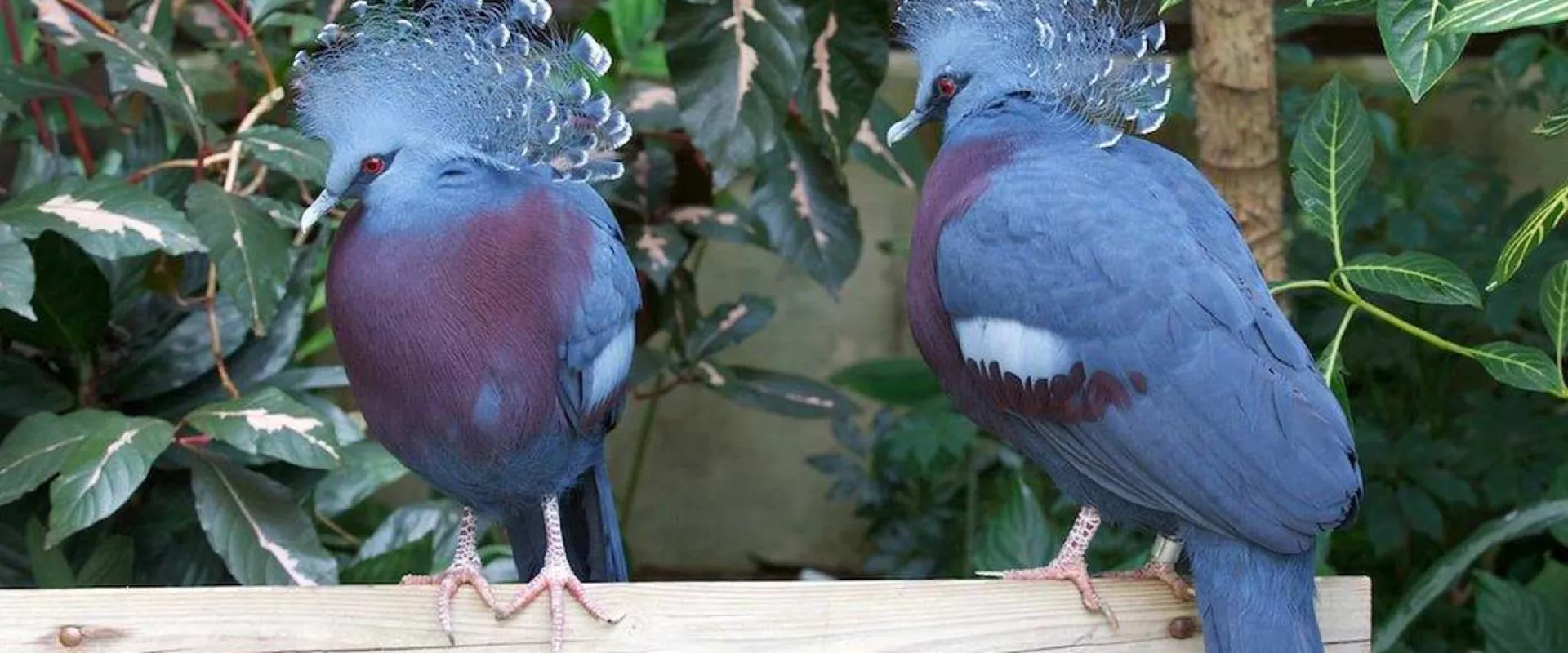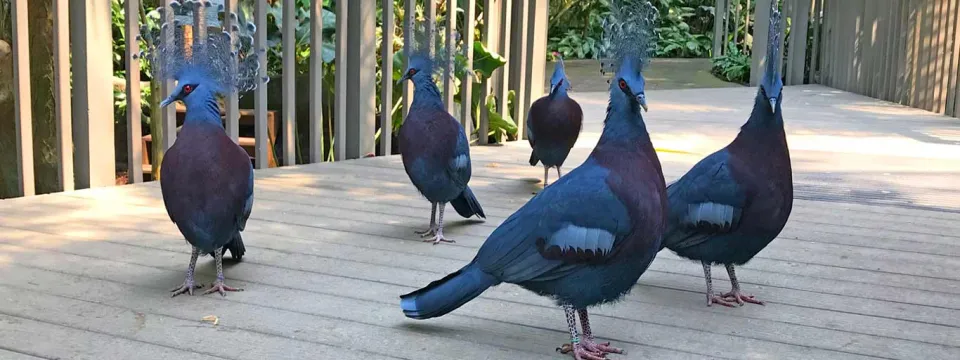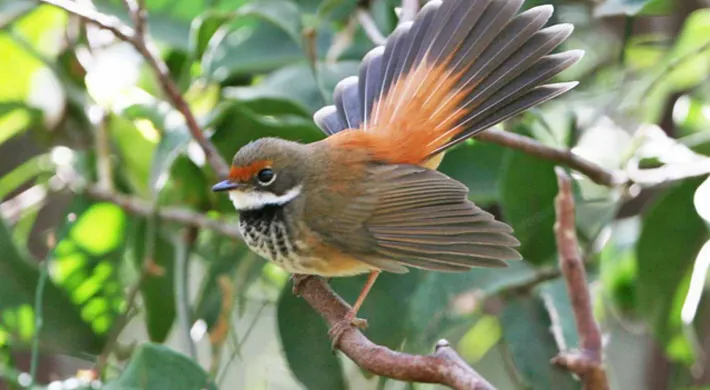Written by Wendy Wadsworth, Animal Management Supervisor, North Carolina Zoo
A Royal Family is wandering around the North Carolina Zoo Forest Aviary….the very regal Victoria-crowned pigeons! Enter the Forest Aviary and encounter a family of five extraordinary pigeons (said to be named after the British Monarch Queen Victoria) with magnificent blue-grey plumage, red eyes, black masks and elegant, lacy fan-like crests.
The natural range of Victoria-crowned pigeons are in swamp and lowland forests of New Guinea, Indonesia and a few surrounding islands. The Zoo’s Aviary simulates this type of habitat, thus allowing this species of pigeon to thrive and reproduce. The Aviary is spacious, lush, and mimics the ideal temperature and humidity of a tropical forest. It is filled with tropical plants and trees, providing ample choice of suitable nesting materials and locations. Food is abundant, whether provided by the keepers or found on the forest floor, where Victoria-crowned pigeons can forage on fallen fruit from the various fruiting trees within the Aviary.
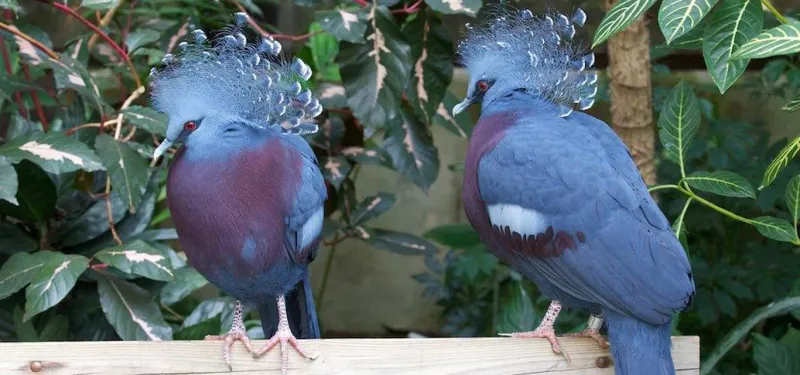
In November 2017, a female and male Victoria-crowned pigeon were introduced to one another and immediately formed a pair bond. Within months, the male was often observed courting the female – the male dances around the female while bowing his head up and down, fanning his tail feathers and sounding a loud “booming” call. The female was impressed and accepted this male as her new mate. They chose a nest site in a rose apple tree, eight feet from the ground. The male collected twigs, sticks, leaves, and palm and banana fibers and carried to the female at the nest site, where she constructed the platform nest. An egg was laid, and the pair swapped incubation duties for 30 days. In early August 2018, the egg hatched! For the next month, both parents cared for the chick in the nest, first feeding her nutrient-rich crop milk for a few weeks and then slowly introducing fruit to her diet. By early September 2018, it was time to leave the nest, and for the next several months, the first-time parents guided, protected and cared for her as she grew and learned how to be a pigeon. This was the first successful Victoria-crowned pigeon offspring at North Carolina Zoo since 1994.
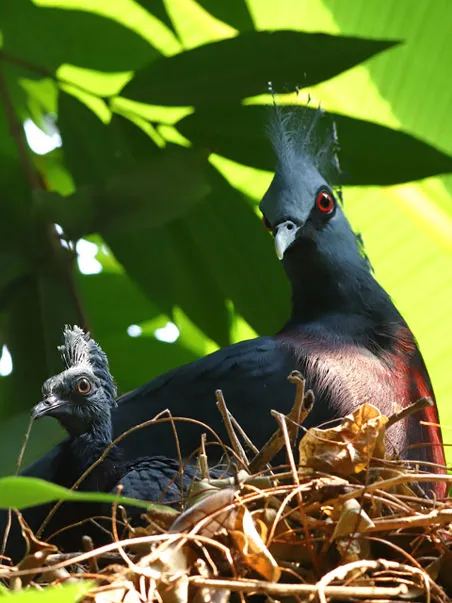
Victoria-crowned pigeon in nest with chick
In May 2019, the parents opted to grow the family. They built a nest (this time twenty feet high in a banyan tree), laid an egg and the egg hatched in early June 2019. The chick, who turned out to be a male, fledged (left) the nest in early July 2019, to make a family of four.
In late October 2019, the parents added one more to the family group! Their first two offspring became fast buddies and hung out together while the parents constructed another nest high in the banyan tree. An egg was laid and hatched in early December 2019. The chick, another girl, fledged the nest in early January 2020. The outstanding parents again cared for this offspring….and then there was a family of five.
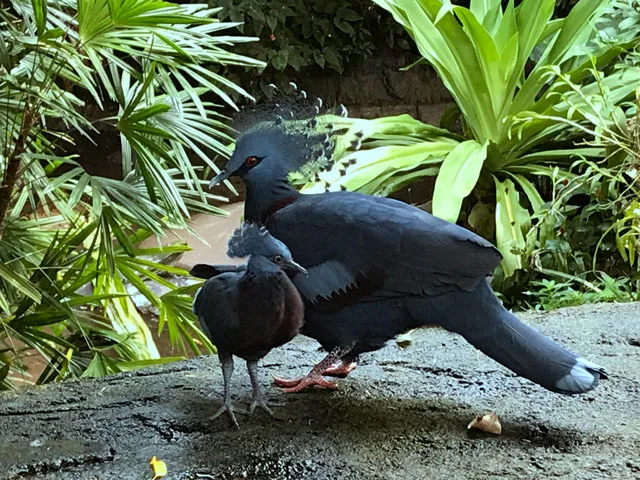
Victoria-crowned pigeon fledgling
In their natural range, Victoria-crowned pigeons can be gregarious – living together, feeding together, roosting together and breeding in small groups. Most aviaries at zoos have the ability to house a pair of Victoria-crowned pigeons but not groups. Often, once a juvenile is weaned, and if the parents go to nest again, the juvenile is separated from the parents, due to space limitations of housing several Victoria-crowned pigeons together. However, the spacious and ideal environment of the Zoo’s Aviary allows for breeding the species in a socially appropriate manner. And of note, both our adult female and adult male were raised in family groups at the zoos where they were hatched. Thus, the optimal Aviary habitat, coupled with the life history and individual dispositions of our adult pair, support housing a family group within our Forest Aviary.
Victoria-crowned pigeons are one of the many Association of Zoos and Aquariums (AZA) Species Survival Plans (SSP). SSP’s maximize genetic diversity and long-term sustainability of animal populations in AZA zoos. We strive to sustain a healthy population within zoos, as the natural range population is decreasing (listed as Near Threatened through the International Union Conservation and Nature’s Red List) due to hunting (for meat and feathers) and logging (for oil palm plantations and to open roads for hunting). The AZA North America population maintains 100-125 Victoria-crowned pigeons, within 35-45 zoos.
As the SSP Coordinator and studbook keeper for the AZA North America population of Victoria-crowned pigeons, I work with a population advisor at AZA’s Population Management Center every few years, to perform extensive genetic and demographic analyses on the population and produce a Breeding and Transfer Plan.. This plan makes recommendations for best genetic pairings of birds for breeding and locations for transfers, all in an effort to effectively grow and sustain the North American population of Victoria-crowned pigeons in zoos.
Picture Above: Family of Victoria-crowned pigeons in the Aviary
What is the future for the juvenile Victoria-crowned pigeon’s at the North Carolina Zoo?.....per the SSP, all the offspring will eventually be recommended to transfer to other AZA zoos and most likely paired to breed and continue to help grow and sustain the population of Victoria-crowned pigeons. How they were raised and what they learned at the North Carolina Zoo will undoubtedly carry over to future generations of Victoria-crowned pigeons. And so, the royal crown will be passed to generations to come….after all, who wouldn’t want a royal family in their Aviary?
